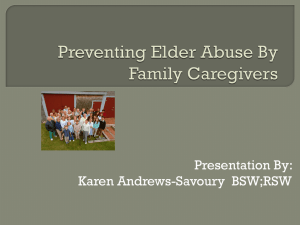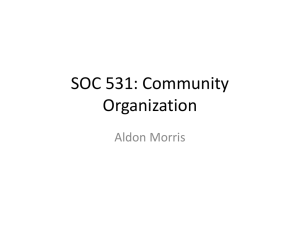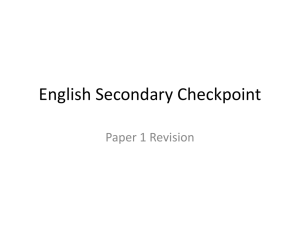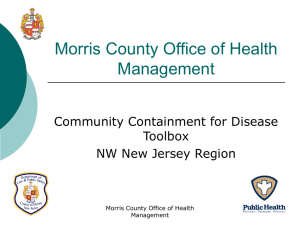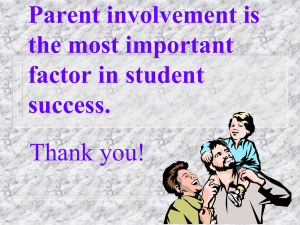NFOrientation - University of Minnesota, Morris
advertisement
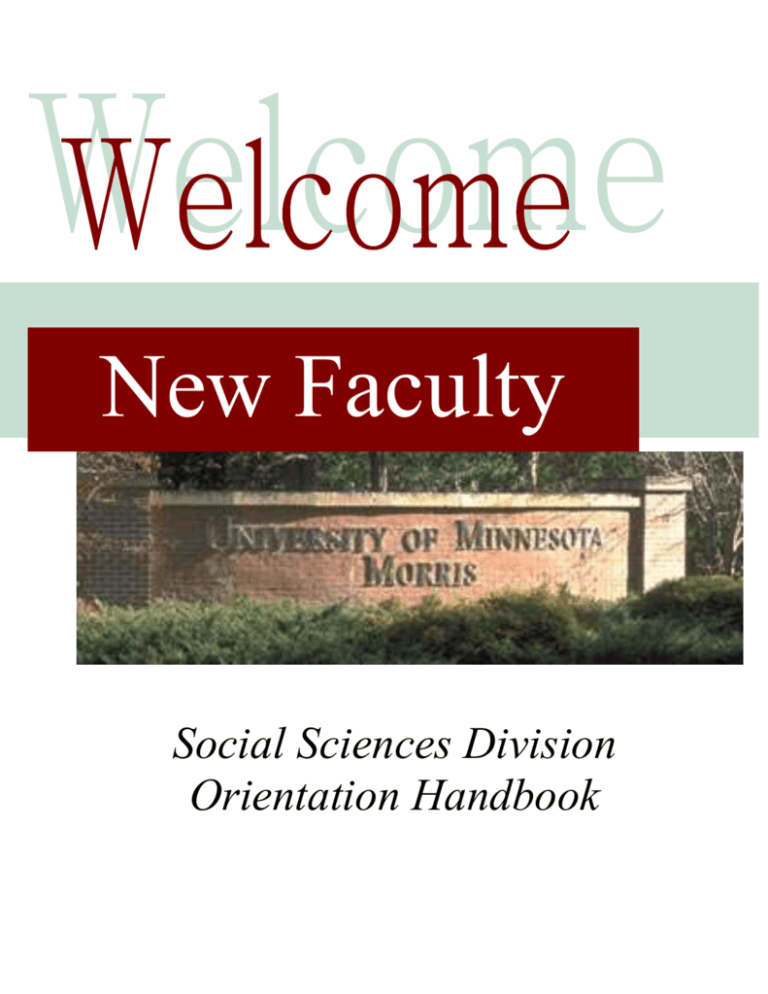
New Faculty Social Sciences Division Orientation Handbook Table of Contents Welcome Division Chair Welcome UMM Mission Statement About UMM Student Profile Green Initiative UMM Governance Administrative Organization Campus Map Settling In New Faculty Checklist From the Office of the Registrar Academic Calendar Final Exam Calendar Division of Social Sciences Current Faculty Discipline Coordinators Classroom Suggestions Grading Standards Sample Syllabus Evaluation Examples Writing Criteria City of Morris City Map Chamber Welcome Events Useful City Numbers 3 4 5 6 7 8 9 10 11 12 13 14 15-17 18 19 20-27 28-30 31 32 33 34 35-36 2 Welcome Division Chair Welcome Pareena G. Lawrence Welcome to UMM and the Division of Social Sciences. We are excited that you have chosen to join us. The UMM Social Science Division is comprised of dedicated and talented faculty and staff across fields as diverse as Anthropology, Economics, History, Liberal Arts for Human Services, Management, Political Science, Psychology, Social Science, Sociology, and Gender, Women and Sexuality Studies. Our mission is to provide a rigorous undergraduate liberal arts education to a diverse student body. The Social Science Division is committed to outstanding teaching and learning, support for both faculty scholarship and undergraduate research, and genuine outreach and engagement with our surrounding world. When our students graduate, they have had a personalized educational experience that prepares them to be global citizens who value and pursue intellectual growth, civic engagement, intercultural competence, and environmental stewardship. The mission of the Division of Social Sciences is to foster a dynamic academic climate and to support faculty scholarship and student scholarship. The Division of Social Sciences supports the mission of the University of Minnesota, Morris by: Providing essential aspects of a liberal arts education through understanding humans in their diversity as expressed in their histories, ideas, institutions, and behaviors. Providing service in cooperation with other offices and programs to the campus and the greater community that contribute to the discovery and dissemination of knowledge to the Social Sciences and related fields. Providing our students with core knowledge of their chosen majors, and competence in the methodologies, techniques, and skills required in their fields. 3 UMM Mission and Vision Mission The University of Minnesota, Morris (UMM) provides a rigorous undergraduate liberal arts education, preparing its students to be global citizens who value and pursue intellectual growth, civic engagement, intercultural competence, and environmental stewardship. As a public land-grant institution, UMM is a center for education, culture, and research for the region, nation, and world. UMM is committed to outstanding teaching, dynamic learning, innovative faculty and student scholarship and creative activity, and public outreach. Our residential academic setting fosters collaboration, diversity, and a deep sense of community. —Approved by Campus Assembly April 2009 Vision The University of Minnesota, Morris’s vision focuses on students: to provide a personalized education for each student; to complement and enrich extraordinary classroom experiences through undergraduate research, the Honors Program, study abroad, civic engagement, service learning, on and off campus internships, and the National Student Exchange; to support and nurture the collaborative nature of the Morris campus and its deep sense of community; to celebrate and strengthen the multicultural inclusiveness of the campus community; to increase and strategically manage resources, including scholarships, to provide the best educational value possible for Morris students; to become effective stewards of our environment and serve as a national leader in areas of sustainable energy and green living; to recruit and retain outstanding students, faculty, and staff; to nurture and support all members of the campus community, creating a climate of forthrightness, trust, and mutual respect. 4 History of UMM: From Boarding School to Liberal Arts The University of Minnesota, Morris makes its home on a 118 year-old campus. The first buildings housed an American Indian boarding school, first administered by the Sisters of Mercy order of the Catholic Church and later by the United States Government. The school closed in 1909, and the campus was transferred to the State of Minnesota with the stipulation that American Indian students "shall at all times be admitted to such school free of charge for tuition," a policy the campus proudly honors. The current Multi-Ethnic Resource Center is the only remaining building from the American Indian boarding school period. In 1910 the U of M established the West Central School of Agriculture on the campus, which successfully educated the area's high school students in a boarding school environment until 1963. It is this time period that garnered the campus its placement on the National Register of Historic Places as the West Central School of Agriculture and Experiment Station Historic District. Handsome Prairie School structures, such as Behmler Hall and the Education building, built during the WCSA years and designed by well-known state architect Clarence H. Johnston, Sr., continue to serve the campus well. In the late 1950s when the U of M announced that agricultural schools would be phased out, a grass roots citizens movement convinced the Minnesota Legislature that creating a distinct public liberal arts college within the University of Minnesota system on the Morris campus would be a good investment for the state. In September 1960 the University of Minnesota, Morris opened its doors and began fulfilling its institutional vision to be an affordable, undergraduate, small, residential, public liberal arts campus. 5 Student Profile Morris Students are extremely active in everything and anything they can get their hands on including student-run organizations, faculty partnerships, internships, musical groups, theatre groups, athletics, undergraduate research projects, study abroad, campus events and community events and projects. Be prepared and excited to work with a talented, enthusiastic, engaged and passionate group of young adults! Enrollment: 1,700 students Student of Color Population: 15% (the highest in the University of Minnesota) 7% American Indian 3% African American 3% Asian American 2% Hispanic Number of Student Organizations: More than 80 Class Profile: 35% of students graduated in the top 10% of their high school class and nearly 60% graduated in the top 20% The ACT composite average is 25; mid 50% range is 23-28 6 Biomass Gasification Plant (Next to RFC) Wind Turbine Green Eating, Local Foods Green Vehicles, UMM Prius Fleet Environmental Studies Major Energy Wars (Between Residence Halls) Energized Students! Sustainability West Central Outreach Center The University of Minnesota, Morris is deeply rooted in the tall prairie grass and connected to the blue prairie sky. The campus community has advanced sustainable, environmentally friendly initiatives since the original Earth Day. Since 2000, these efforts have grown to levels of national leadership and touch nearly all aspects of campus life – power, food, water, transportation, waste stream infrastructure, academic study, and quality of life. 7 Governance at UMM http://www.morris.umn.edu/about/organization/ 8 Administrative Organization Administrative Organization University of Minnesota Morris 9 Campus Map 600 East 4th Street Morris, MN 56267 10 Settling In Three staff members are going to be very helpful in the coming months as you are becoming oriented at UMM. Their names are Sharon Severance, Laura Burks and Terri Hawkinson and they work in the Social Sciences division office. The checklist below is something that should be taken care of before the start of classes. Items on the list can be completed by contacting or meeting with the listed staff member. Extra spaces are provided for you to fill in other obligations you need to complete. The list on the next page is an important note from the registrar’s office. New Faculty Checklist See Terri Get keys See Sharon or Laura Computer set-up E-mail set-up Mailbox set-up UMM ID card (Business Office) Budget Overview Copier Code Division meetings schedule Classroom Listservs Library Bookstore Exams and Make-up exams Laptop registration Get local address and phone Voicemail instructions Business cards Duplicating materials, including exams Web grading Web grade changes Work/study Syllabus Policy Other Emergency contact information to Laura Burks Benefits – Sarah Mattson Getting paid – Mary Zosel, Payroll Parking pass – Business Office, Behmler Hall 11 From the Office of the Registrar Class Lists: Faculty are encouraged to check their class lists frequently during the first two weeks of each semester. Any student attending the class whose name does not appear on the class list report must officially register for the class. Petitions for retroactive registrations may not be approved. You can obtain an up-to-date list of students who are registered for your classes by going to Management Reporting at: www.umreports.umn.edu, after you are logged in, typed ‘My Classes’ next to the Search Reports tab located in the upper right-hand corner. Class permission numbers: Class permission numbers, also known as ‘magic numbers’, replace faculty signatures and not only protect your signature but allows students to register for classes for which they need your approval online. Permission numbers can be accessed through Management Reporting, type ‘Class Permission Numbers’ next to the Search Reports tab located in the upper right-hand corner. Permission numbers are required under the following terms: 1) Prerequisite Instructor Consent (if you are unsure of this you can look at the prerequisite information in the Class Schedule), 2) Closed Courses: Allowing students to register for classes that have been closed due to reaching maximum capacity, 3) After 1st Week of Classes To see if your class has a waiting list, follow the same steps as finding an up-to-date class list for your course. The following link will aid you in submitting grades: www.morris.umn.edu/services/registrar/grading/index.php The following link lists important dates regarding dropping/adding classes: www.morris.umn.edu/services/registrar/canceladd.html The following link to an index of resources and documents: www.morris.umn.edu/services/acad_affairs/aavarious.html 12 Academic Calendar Fall Semester 2009 Monday August 17, 2009 Sunday – Tuesday August 23 – 25, 2009 Wednesday August 26, 2009 August 26 – October 16, 2009 Monday September 7, 2009 Monday – Tuesday October 19 – 20, 2009 October 21 – December 11, 2009 Thursday – Friday November 26 – 27, 2009 Friday December 11, 2009 Saturday December 12, 2009 Monday – Thursday December 14 – 17, 2009 Faculty Return New Student Orientation Fall Semester Classes Begin 1st Half of Term Classes Offices closed – official Labor Day holiday Fall Break (no classes) 2nd Half of Term Classes Offices closed – official Thanksgiving holiday Last Day of Instruction Study Day Fall Semester Examinations Winter Break December 18, 2009 – January 18, 2010 December 24 – 25, 2009 December 31, 2009 – January 1, 2010 Winter Break Offices closed – official holiday Offices closed – official New Year’s holiday Spring Semester 2010 Monday January 18, 2010 Tuesday January 19, 2010 January 19 – March 12, 2010 Monday – Friday March 15 – 19, 2010 Friday March 19, 2010 March 22 – May 7, 2010 Friday May 7, 2010 Saturday May 8, 2010 Monday – Thursday May 10 – 13, 2010 Saturday May 15, 2010 Offices closed – official Martin Luther King, Jr. holiday Spring Semester Classes Begin 1st Half of Term Classes Spring Break Offices closed – official floating holiday 2nd Half of Term Classes Last Day of Instruction Study Day Spring Semester Examinations UMM Commencement May Session 2010 Monday May 17, 2010 Monday May 31, 2010 Friday June 4, 2010 May Session Begins Offices closed – official Memorial Day holiday May Session Classes End Summer Session 2010 May 24 – June 25, 2010 Monday May 31, 2010 June 28 – July 30, 2010 Monday July 5, 2010 1st 5-Week Summer Session Offices closed – official Memorial Day holiday 2nd 5-Week Summer Session Offices closed – official Independence Day holiday For future reference: http://www.morris.umn.edu/onestop/Calendars/2009-2010.html 13 Fall Final Exam Calendar Regular Class Time Class Start Time Days of Class 8:00 AM MWF 8:00 or 9:00 AM TTH 9:15 AM MWF 10:00 or 11:00 AM TTH 10:30 AM MWF 11:45 AM MWF 12:00 or 1:00 PM TTH 1:00 PM MWF 2:00 or 3:00 PM TTH 2:15 PM MWF 3:30 PM MWF 4:00 or 5:00 PM TTH 4:45 PM MWF Final Exam Schedule Final Exam Time Day 8:30-10:30 AM Tues 8:30-10:30 AM Thurs 8:30-10:30 AM Mon 11:00-1:00 PM Wed 11:00-1:00 PM Thurs 11:00-1:00 PM Mon 1:30-3:30 PM Thurs 1:30-3:30 PM Tues 1:30-3:30 PM Wed 4:00-6:00 PM Mon 4:00-6:00 PM Wed 4:00-6:00 PM Tues Arranged Date Dec 15 Dec 17 Dec 14 Dec 16 Dec 17 Dec 14 Dec 17 Dec 15 Dec 16 Dec 14 Dec 16 Dec 15 Spring Final Exam Calendar Regular Class Time Class Start Time Days of Class 8:00 AM MWF 8:00 or 9:00 AM TTH 9:15 AM MWF 10:00 or 11:00 AM TTH 10:30 AM MWF 11:45 AM MWF 12:00 or 1:00 PM TTH 1:00 PM MWF 2:00 or 3:00 PM TTH 2:15 PM MWF 3:30 PM MWF 4:00 or 5:00 PM TTH 4:45 PM MWF Final Exam Schedule Final Exam Time Day 11:00-1:00 PM Wed 11:00-1:00 PM Mon 11:00-1:00 PM Thurs 8:30-10:30 AM Tues 8:30-10:30 AM Wed 8:30-10:30 AM Thurs 4:00-6:00 PM Mon 4:00-6:00 PM Tues 4:00-6:00 PM Wed 1:30-3:30 PM Mon 1:30-3:30 PM Thurs 1:30-3:30 PM Tues Arranged Date May 12 May 10 May 13 May 11 May 12 May 13 May 10 May 11 May 12 May 10 May 13 May 11 For future reference: http://www.morris.umn.edu/services/registrar/final_examNEW.html 14 Current Faculty Division of Social Sciences Anthropology Associate Professor Donna Chollett (1996), B.S., M.A., Iowa State University; Ph.D., Michigan State University Julie Pelletier (2002), B.S., University of Maine; M.A., Ph.D., Michigan State University Assistant Professor Rebecca Dean (2007), B.A., University of Michigan; M.A., Ph.D., University of Arizona Lecturer Joseph Beaver (2009), B.G.S., University of Kansas; M.A., University of Tulsa; Ph.D., University of Arizona Economics/Management Professor Cyrus Bina (2000), B.S., Institute of Advanced Accounting, Tehran; M.A., Ball State University; Ph.D., American University Bart Finzel (1989), B.A., Valparaiso University; M.A., Ph.D., Cornell University Pareena Lawrence (1993), B.A., M.A., Delhi University, India; M.S., Ph.D., Purdue University Associate Professor Stephen Burks (1999), B.A., Reed College; M.A., Indiana University; Ph.D., University of Massachusetts Arne Kildegaard (2001), B.A., Gustavus Adolphus College; M.A., University of Chicago; Ph.D., University of Texas, Austin Sheng Xiao (2009), B.A., M.A., Sichuan University, China; Ph.D., Vanderbilt University Assistant Professor Kevin Stefanek (2009), B.A., University of California, Berkeley; M.S., Boise State University; M.A., Ph.D., Michigan State University Lecturer Philip Deger (2006), B.S., MSIR Loyola University Deb Economou (1995), B.A., Case Western Reserve University; J.D., University of Minnesota Law School Thomas Gausman (2000), B.A., University of Minnesota, Morris; M.S., M.A., Northern Illinois University 15 History Professor Wilbert Ahern (1967), B.A., Oberlin College; M.A., Ph.D., Northwestern University Roland Guyotte (1969), B.A., Brown University; M.A., Ph.D., Northwestern University Harold Hinds, Jr. (1970), B.A., University of Oregon; M.A., Ph.D., Vanderbilt University Associate Professor Stephen Gross (1998), B.A., Ph.D., University of Minnesota, Twin Cities Assistant Professor Jennifer Kolpacoff Deane (2005), B.A., University of Washington, Seattle; Ph.D., Northwestern University Marynel Ryan (2005), B.A., University of Illinois, Chicago; Ph.D., University of Minnesota, Twin Cities Teaching Specialist Zhiguo Ye (2009), B.A., Wuhan University, China; Ph.D., University of Minnesota, Twin Cities Political Science Professor Seung-Ho Joo (1995), B.A., Yonsei University, Korea; M.A., Eastern Kentucky University; Ph.D., Pennsylvania State University Paula O’Loughlin (1996), B.A., Smith College; Ph.D., University of Minnesota, Twin Cities Associate Professor Roger Rose (2009), B.A., Occidental College; M.A., Ph.D., University of California, Davis Assistant Professor Sheri Breen (2007), B.A., Ph.D., University of Minnesota, Twin Cities Psychology Professor Leslie Meek (1995), B.A., University of Minnesota, Morris; Ph.D., University of Michigan Jeffrey Ratliff-Crain (1989), B.S., Ohio State University; Ph.D., Uniformed Services University of the Health Sciences Associate Professor Katherine Benson (1978), B.A., University of Minnesota, Twin Cities; M.S., Ph.D., University of Massachusetts, Amherst Thomas Johnson (1986), B.A., St. Olaf College; Ph.D., University of Minnesota, Twin Cities Dennis Stewart (2002), B.S., University of Illinois at Urbana-Champaign; M.A., Ph.D., Miami University Assistant Professor Jacqueline Greenwood Julien (2006), A.A., Inver Hills Community College; B.S., University of Wisconsin, River Falls; M.A, Ph.D., Argosy University, Twin Cities Heather Peters (2007), B.A., B.S., University of Minnesota, Twin Cities; M.A., University of Arizona; Ph.D., University of California, Davis Cheryl Stewart (2004), B.S., George Mason University; M.A., Ph.D., Miami University, Oxford, Ohio Kevin Stefanek (2009), B.A., University of California, Berkeley; M.S., Boise State University; M.A., Ph.D., Michigan State University 16 Sociology Associate Professor Donna Chollett (1996), B.S., M.A., Iowa State University; Ph.D., Michigan State University Solomon Gashaw (1986), B.A., Haile Selassie I University, Ethiopia; M.L.I., S.J.D., Ph.D., University of Wisconsin, Madison Farah Gilanshah (1988), B.A., National University of Iran; M.A., Ph.D., University of Minnesota, Twin Cities Jennifer Rothchild (2003), B.A., Miami University; M.A., Georgia State University; Ph.D., American University 17 Discipline Coordinators 2009-2010 Anthropology/Sociology Solomon Gashaw Tom Johnson Economics/Management Arne Kildegaard History Wilbert Ahern Political Science Paula O’Loughlin Psychology Dennis Stewart American Indian Studies Julie Pelletier Geography Joe Beaver Latin American Studies Donna Chollett Liberal Arts for the Human Services Leslie Meek Pre-Law Advisor Paula O’Loughlin Social Science Major Steve Gross Gender, Women& Sexuality Studies Jennifer Rothchild Other Division Responsibilities Division Vice Chair Work study and Student Rep. Psychology Lab Manager WC Historical Research Center Division Policy Committee Chair Faculty Affairs Division Rep. Leslie Meek Leslie Meek Leslie Meek Steve Gross Leslie Meek Rebecca Dean 18 Classroom Suggestions Grading Standards: Grade definitions: A – Represents achievement that is outstanding relative to the level necessary to meet course requirements. B – Represents achievement that is significantly above the level necessary to meet course requirements. C – Represents achievement that meets the course requirements in every respect. D – Represents achievement that is worthy of credit even though it fails to meet fully the course requirements. K –Assigned by an instructor to indicate the course is still in progress and that a grade cannot be assigned at the present time. I – (Incomplete) Assigned at the discretion of the instructor when, due to extraordinary circumstances, e.g., hospitalization, a student is prevented from completing the work of the course on time. Requires a written agreement between instructor and student. X – Reported by the instructor for a student in a sequence course where the grade cannot be determined until the sequence is complete – the instructor is to submit a grade for each X when the sequence is complete. For the full uniform grading and transcript policy, visit http://www.fpd.finop.umn.edu/groups/senate/documents/policy/gradingpolicy.html UMM Course Syllabus Requirements and Guidelines: http://www.morris.umn.edu/services/acad_affairs/syllabus.html 19 Sample Syllabus As you are putting together your course syllabi, review this sample of a current professor for help in formatting and content. introduction to women’s studies wost 11o1 spring 2008 Tuesdays & Thursdays—12-1:40pm room 113 Imholte instructor: Dr. Jennifer Rothchild 0ffice: 116A Imholte e-mail: jrothch@morris.umn.edu office hours: Mondays & Wednesdays, 121pm; Thursdays 10-11am teaching assistants: Brittany Jablonsky email: jabl0026@morris.umn.edu Brittany Kill email: kill0104@morris.umn.edu course description This course is designed to introduce students to women’s studies as an interdisciplinary field of knowledge. We will look at questions of identity and social construction (i.e., What do we and others think that “women” are?); the diversity of women’s life experiences (utilizing an intersectional framework that links gender with race, social class, disabilities, sexual orientation, and other social location hierarchies); the variance of women’s life experiences throughout their life courses; the dynamics of social and cultural systems that privilege and oppress women and men in various ways; and the empowerment of women and men who have been subordinated in such systems of power. required reading 1. Andersen, Margaret. 2006. Thinking about Women: Sociological Perspectives on Sex and Gender (7th edition). Boston, MA: Pearson/Allyn & Bacon. 2. Burn, Megan Shawn. 2005. Women across Cultures: A Global Perspective (2nd edition). New York, NY: McGraw Hill. 3. handouts 4. readings on reserve course objectives * to introduce students to the interdisciplinary field of Women’s Studies * to provide a broad overview of diverse feminist theories 20 * to engage in critical thinking, writing, reflection, and dialogue through both written and oral assignments as well as cooperative group work through this course course requirements Your graded work for this class will be evaluated as follows: ♦ class attendance I expect students to attend all class meetings and actively participate in class discussions. This means you will need to do the assigned reading and preparation before each class. The nature of the class depends on students’ completion of assigned reading and active participation in discussions. If you miss class, it is your responsibility to find out what you have missed. 21 course requirements, continued ♦ interviews and analysis paper: “What is ‘Feminism’?” (15%) For this assignment, you will interview five people about how they define the word “feminism” as well as their perceptions of the different types of issues relevant to feminism. You will then analyze and present your findings and analytical conclusions 22 in a 4-6 page paper. At a later date, you will receive a detailed handout regarding this assignment. ◘ due: February 12 guidelines for discussion I propose the following guidelines (gleaned from Professor Lynn Weber at Memphis State) while in this classroom: a) Acknowledge that all of us have learned misinformation about our own group and about members of other groups, whether we belong to an advantaged or 23 disadvantaged group. b) Agree to not blame others or ourselves for the misinformation we have learned in the past, but accept responsibility for not repeating misinformation after we have the course The course syllabus provides a general plan for the class. Please know that changes from this plan may be necessary. week 1: studying women 24 ♦ Tuesday, January 22 topics: introduction: what is women’s studies? assigned reading for next class: chapter 1 in Andersen book; ch. 1 week 5: socialization ♦ Tuesday, February 19 topics: socialization of gender assigned reading: chapter 2 in Andersen book ♦ Thursday, February 21 topics: agents of socialization assigned reading: chapter 3 in Andersen book 25 ♦ Thursday, April 3 topics: women and international politics assigned readings: chapter 9 in Burn book week 11: women and development ♦ Tuesday, April 8 topics: women, feminism, and international development assigned readings: chapter 6 in Burn book ♦ Thursday, April 10 26 27 Example 1: Midsemester Evaluation 1. What do you like about this course and what would you not want to change? 2. What do you not like about this course and what would you want to change? 3. Do you like this instructor’s teaching style? Please explain your answer. Example 2: Group Evaluation Name:_________________________ Number:_______________________ First, list all of your group members including yourself. Second, identify about how much work each person did. The numbers should add up to 100. So if you have three group members and you each did the same amount of work, you will put 33.3 for each member. If some students did more than others, you will adjust accordingly. Third, identify what grade you think each person deserves and explain your response. 1. 2. 3. 4. 28 Example 3: End of Semester Personal Evaluation Evaluation for PSY 3302 – Personality – Fall 2007 How well do you feel this course achieved its objectives? Please rand the below objectives on the following scale. 1 Did not Achieve 2 3 Somewhat Achieved 4 5 Totally Achieved 1.___Introduce you to the field of Personality Psychology through theory, research, & application 2.___Examine and evaluate classic and contemporary theories and research relating to personality 3.___Discover how personality psychology contributes to your understanding of real world issues 4.___Encourage self-reflection on your own personality 5.___Become a critical consumer of psychological information 6.___Express your ideas verbally and on paper, and to think outside of the box thus, expand upon what is presented to you by applying it to different areas of your life What did you especially like about this course and would not want to change if you were teaching the class? What did you especially not like about this course and would want to change if you were teaching the class? How much do you feel that you have learned in this class? Please explain your response. 29 Did the instructor pay attention to student feedback? explain your response. Please Please comment on the instructor’s teaching effectiveness. Do you like the instructor’s teaching style? your answer. Please explain Any other comments you would like to share with the instructor? 30 Writing Criteria When asking students to write a paper, in intro level classes, it may be helpful to provide an outline of your expectations. Professor Michael Lackey of the English discipline offers his students the following criteria for writing effective papers. Taking such steps helps students and professors by improving students’ writing skills. Michael Lackey The Effective Paper: 1) Students demonstrate a commanding grasp of the subject matter. Specifically, students will indicate through the content and tone of their writing that they have seriously examined the material and carefully reflected on the implications of their position. In short, writers will not only communicate effectively but also inspire readers to trust and respect their ideas and judgment. 2) Students carefully and intelligently analyze primary sources, adequately examining the subtleties and implications of the evidence and clarifying precisely how the evidence justifies the primary assertions. It is not enough to say that something can be interpreted in a particular way. Writers must specifically justify why their interpretation is compelling and convincing. Finally, the relationship of the evidence to the thesis must be clear. 3) Starting with the title, students engages readers. In the introduction, the writer skillfully orients the reader to the material, indicating the issue (thesis) at stake and the direction the writer’s argument will take. Put simply, the writing must be clear and engaging. 4) Throughout the essay, the student offers insightful and compelling arguments that are clarified and supported with suitable evidence. 5) The material must be logically organized. The reader should get the sense that the paragraphs are in exactly the right order as dictated by the material. Moreover, the writer needs to use appropriate transitions to clarify the movement in logic from one idea to the next. 6) The writing must be fluent and graceful. How things are said must contribute to the reader’s enjoyment and punctuate the writer’s argument. 7) The writer must have an appropriate feel for the language, which results in suitable word choices. 8) The paper must conclude with a bang, not a whimper. Your reader should feel that you have communicated something important or brought some clarity to a complex issue. 9) The essay is generally free of grammar, spelling, and punctuation errors. Morris, Minnesota 31 City Map 32 Welcome from Morris Chamber of Commerce “This city of Morris has a longstanding tradition for dedication to community. On behalf of the business owners of Morris, we extend our warmest welcome to you as a new member of our community. Many members all come together everyday in our cities pristine parks, local businesses, farms, community buildings and the University of Minnesota, Morris to form a strong network of coworkers, neighbors, and most of all friends. Whether you find yourself frequenting Don’s Café for shakes, Common Cup Coffeehouse for an open mic night or East Side Park for a community picnic, we hope that the contentment, sense of accomplishment and friendliness that this network has created follows you wherever you go. We hope, before long, you will join us in proudly calling Morris your home.” Pomme De Terre Park, June 2008 33 City Events Prairie Pioneer Days is Morris’ largest community festival. Held during the 2nd weekend in July, this celebration features food & craft vendors, entertainment and other events, walk-run, parade, the Miss Midwest pageant and fireworks. Centered around East Side Park in Morris. August 29 & 30, 2009 Donnelly Threshing Bee- Donnelly, MN August 27, 2009 Picnic in the Park -East Side Park September 12, 2009 Morris Area Chamber Golf Tournament -Pomme de Terre Golf Club – 10 am start – register with the Chamber at 320-589-1242 September 19, 2009 Harvest Fest -Lee Community Center, 9:00-3:00 November 19, 2009 9th Annual Grand Parade of Lights 6 p.m. Downtown Morris (Atlantic Avenue) Sponsored by the Morris Area Chamber of Commerce 320-589-1242 34 Useful City Numbers City Resources Airport Shuttle to Minneapolis Contact Rentz Agency (320) 589-2442 Community Development Stevens County Economic Improvement Commission 507 Atlantic Ave. (320) 585-2609 http://www.sceic.org Day Care Childcare Resource and Referral 1-800-452-3646 Emergency Hospital: (320) 589-1313 Fire Department: 911 Libraries Morris Public Library 102 East 6th St. (320) 589-1634 http://www.viking.lib.mn.us Rodney A. Briggs Library (UMM)600 East 4th St. (320) 589-6175 www.morris.umn.edu/library Morris Chamber of Commerce 507 Atlantic Ave. (320) 5891242 Morris City Hall 609 Oregon Ave. (320) 589-3141 http://ci.morris.mn.us Morris License Bureau 600 Atlantic Ave. (320) 589-1755 Realtors American Eagle Realty 202 E 7th St Morris, MN 56267 320-589-4200 Hoffman Realty 613 Atlantic Ave Morris, MN 56267 320-589-2159 Rentz Agency PO Box 596 517 Atlantic Ave Morris, MN 56267 320-589-2442 West Central Realty 405 Atlantic Ave Morris, MN 56267 320-589-1130 Recreational Activities Crystal Lanes Bowling 808 West 5th Street (320) 589-0232 Lee Community Center County Rd 22 (320) 589-4585 Pomme de Terre Golf Club South Highway 9 (320) 589-1009 Prairie Renaissance Cultural Center 630 Atlantic Avenue (320) 585-5037 Morris Theater 12 E. 6th Street (320) 589-2200 University of Minnesota West Central Outreach Hwy 329, East of Morris (320) 589-1711 US Fish and Wildlife Service Wetlands Office County Road 10, across from Pomme de Terre Park (320) 589-1001 35 Education Kids in Christ Preschool 311 South Columbia Ave (320) 589-2744 Morris Area High School (320) 589-4400 Morris Area Public Elementary (320) 589-1250 St. Mary’s School (320) 589-1703 Morris Community Education (320) 589-4394 Midwest Special Education Cooperative (320) 589-4248 Parks Green River Park Located on Green River Road. East Side Park Located on East 7th Street. The Eagles Ball Park Located on East 7th Street. Kjenstad Park Located along the shores of Lake Crystal. Thedin Park Located on corner of Lyndale and West 6th St. Riverside Park Located in the Riverside Addition. Pomme De Terre Park Located just east of Morris on City Rd. 10 For shelter reservations and information, please call the Morris City Hall at (320) 589-3141. Churches Assumption Catholic Church 209 E 3rd St (320) 589-3003 Newman Catholic Center 306 E 4th St (320) 589-1647 Bethel Evangelical Lutheran Church (CLC) 22 Brook Street (320) 589-4755 Evangelical Free Church 901 Scotts (320) 589-2808 Faith Lutheran Church (ELCA) 108 W 8th Street (320) 589-2970 First Baptist Church 601 Lyndale (320) 589-4163 First Lutheran Church (ELCA) 200 E 5th Street (320) 589-3242 Hosanna Worship Center 46303 Hwy 28 (320) 589-8807 Jehovah’s Witnesses (320) 795-2705 Morris Community Church 211 E 6th Street (320) 589-4510 The Federated Church (United Church of Christ & United Methodist Church) 200 S. Columbia Ave (320) 589-1153 St. Paul’s Evangelical Lutheran Church (WELS) 301 W 5th Street (320) 589-1840 Zion Lutheran Church (LCMS) 311 S. Columbia Ave (320) 589-2744 All the above churches welcome visitors. Please call their respective offices for more information. Health Care Stevens Community Medical Center (320) 589-1313 Prairie Medical Center (320) 589-4008 Stevens/Traverse Public Health (320) 589-7425 St. Francis Health Care Services (320) 589-2004 West Wind Village (Nursing Home) (320) 589-1133 320-589-4481 36
